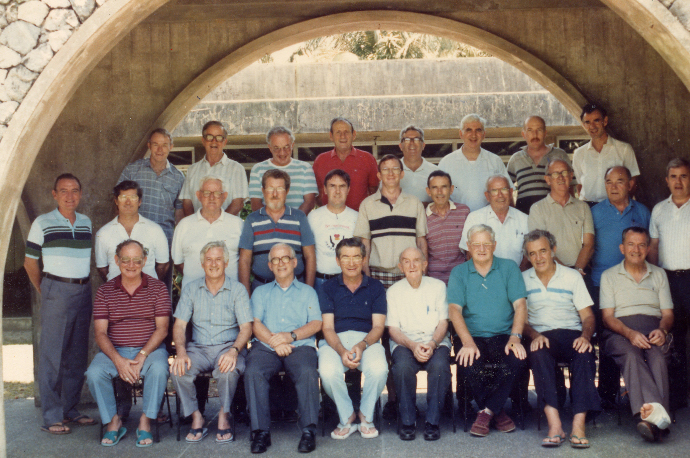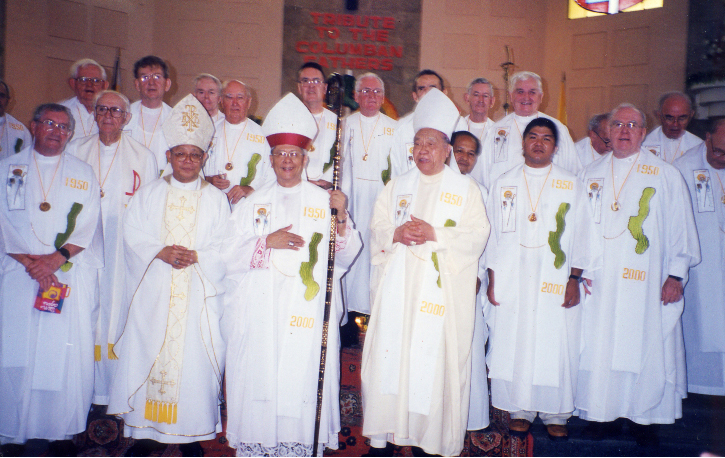Who Are The Columbans?
By Jack Pamine
Jack Pamine, originally from Bohol, lives in Bacolod City and worked with the Columbans from 1993 until 2010. Here he writes about Columban priests he has known and worked with.
Who are the Columbans? That was the lingering question I had. Later, I understood that it is hard to find the collective identity of the group but that its strength is found in each member's spirituality and charism. How each tries to live his missionary life is really amazing. What you find is individual Columbans, each trying to live his vocation to the fullest. The Society of St Columban is not meant to be a religious community but a group of priests committed to working overseas on mission, building up the local Church.
To work for and with the Columbans wasn’t an easy journey because of the strong individuality of each one. But I found them life-affirming of the uniqueness of each person. In the early part of my work, I found it absurd to wake up at midnight to make a long bus trip, spend less than an hour with a family and run back to the terminal to catch the last bus back to Bacolod.
Even in bad weather, I really had to travel because I’d already arranged a schedule in schools. Sometimes I had to travel by sea, which I’m afraid of because I can’t swim. I was thinking back then of working for the security my family, but the challenge of seeing and working with Columbans with their individual gifts and the thought of participating in their mission was simply energizing.
Traveling and meeting new people in schools kept me going. After a year, Fr Terence Bennett, who had hired me to work with him in the vocations ministry, left me alone when he became a parish priest. He gave me some office space but I decided to transfer to the late Fr Niall O'Brien's place where he edited Misyon. I was happy he accepted me. I had a small table and a computer. With Fr Bennett I had used a typewriter but Fr O'Brien insisted I use a computer and made sure I got one.
I found the Columbans interesting because when you meet people, they never talk about the Society of St Columban but about the individual priests. Their presence was still felt strongly in the 1990s in southern Negros Occidental where they had been working since 1950, Catholic school principals had been hired by Columbans and their stories were very encouraging. That kept me going as well.
I learned so much from most of the Columbans I met. I learned many values in life from them, especially the priests assigned to Vocations. Those who weren’t deserve another article, like the late Fr John Doohan and his younger brother Father Michael, still living in Binalbagan, Negros Occidental, the late Fr Colum O'Halpin whose young brother Father Aodh was a Columban in Mindanao for many years, now in London, Fr Patrick Hurley, whose late Columban brothers, Frs Dermot and Gerry, were in Fiji for many years and is sister Catherine, happily living, served a term as Superior General of the Columban Sisters, the late Fr Liam Heffernan, Fr Paul Richardson and most especially the ever-smiling, most saintly priest, Fr Edward Allen who died in the Columban house in Himamaylan City, Negros Occidental, in 2001 at the age of 94. Each of these priests would need a separate book to capture his life.
I will start with Fr Terence Bennett, the Columban who hired me. I learned the value of commitment and fidelity to priesthood from him. Many people described him as ‘the most handsome priest’ with his penetrating blue eyes. I discovered that Fr Bennett had spent his early years in the Philippines as a chaplain of St Paul’s College, now St Paul University, Dumaguete City.
Then Fr Declan McNaughton, now in Scotland, a priest whose 'actions speak louder than words’. Though we never worked together, I never had a ‘no’ answer when I asked something from him. It was through him that I first had the use of a Columban vehicle for my work. Fr Michael Mohally, when he was assigned to vocations work, taught me the value of generosity. We used to refund the travel expenses of high school students who came for ‘search-ins’. I was strict in refunding only the exact amount. But Fr Mohally told me to be generous and understanding, especially with those from poor families who might be visiting a city for the first time. That has stuck to my heart until now.
Fr Seán Coyle is known for his punctuality and since we worked in the same house, I found other virtues in him like his softness of heart towards those in need. I saw in Fr Pat O'Donovan kindness, understanding, compassion and flexibility. He taught me those virtues because he lived them.
I would like to mention Fr Rufus Halley, murdered in Lanao del Sur on 28 August 2001. We went to Antique together and I admired him for his simplicity and empathy with Muslims. Fr Niall O’Brien was the first priest to ask forgiveness from me.
My formation was towards a missionary community and the decision to work for the Columbans was one to continue my service to the Church. Each individual Columban continued to form me as I am today and with a heavy heart I left them for another journey.
How did I come to meet the Columbans? The day in March 1994 that Fr Terence Bennett came looking for me in Domus Dei, the residence for sick and old priests in Bacolod City, recently replaced by a new home in nearby Silay City, is still clear in my memory. I had just been talking with retired Bishop Antonio Y. Fortich of Bacolod about the problems of the BCC-CO (Basic Christian Community-Community Organizing, Visayas) of which he was chairman. I was then attached to the office of the Vicar General of the Diocese of Bacolod, Monsignor Ramon Tirania Jr, for the implementation of the Second Plenary Council of the Philippines (PCP-II) in the diocese.
A towering person, in a white long-sleeved shirt came in and in a hoarse voice said, ‘I am Fr Bennett, a Columban priest. Are you willing to work with us?’ I asked, ‘What is the work, Father?’ He replied, ‘Vocation work, I need somebody to work with me. I am the Vocation Director of the Columbans’. The rest is history.
When Fr Bennett approached me, I was in the middle of a discernment process, whether to stay in Negros, transfer to Cebu or go back to Davao where my family had moved from Bohol when I was a child. I was asking for a sign. The offer by Fr Bennett was the answer to that discernment. ‘I will try’ was my decision, as I could feel the urgency of the need of the Columbans and started to work even without papers to back up my employment. The funny thing was that on the first day of my work, I was asked by Fr Bennett to clean his working table with sandpaper. I said to myself, ‘I thought I would be in vocations work, but here I am doing a manual job. Am I in the right place?’ But my ‘trying’ was to last for more than 17 years.
Being humbled on that first day made me interested to know the Columbans more, and I fell in love during the process. Had I known the Columbans earlier, my life story might have been different. I could have joined them as a missionary of the Church. There were many stories I heard about them in the course of my work and I witnessed some of their achievements. In all honesty, if given the opportunity, I would spend the rest of my life writing about those achievements. I haven’t completely severed my ties with the Columbans. I will be working closely with one of the most controversial Columbans alive, Fr Brian Gore of the Negros Nine because I will be working as Administrative Officer of the Niall O'Brien Center.
You may contact the author at jpamine@yahoo.com


